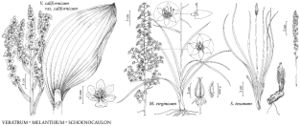Difference between revisions of "Melanthium virginicum"
Sp. Pl. 1: 339. 1753.
FNA>Volume Importer |
FNA>Volume Importer |
(No difference)
| |
Revision as of 19:33, 24 September 2019
Rhizomes 0.5–2 × 0.5–1.8 cm; bulbs 0.6–2.5 cm. Stems 1/4–1/3 floriferous, 0.6–2 m. Leaf blades linear, long-attenuate, 30–80 × 0.6–3.2 cm, apex acute. Inflorescences 1.3–8 dm; terminal raceme 1–2.6 dm; secondary racemes spreading to ascending, 0.2–1.1(–2.2) dm; tertiary racemes infrequent; bracts obovate to subulate, green to brown, 2–4(–6) mm, densely floccose abaxially and marginally. Tepals greenish yellow, aging dark reddish purple, ovate to obovate-oblong, 5.5–13 × 2.2–6 mm, base abruptly auriculate to hastate, clawed, margins entire, apex acute, claws 0.5–1.2(–2.5) mm; glands yellowish green, oblong to oblong-ovate, nectariferous; stamens 6.5–8.5 mm; filaments inserted at or above middle of claw, 0.7–2.5 mm from ovary base, not basally dilated, equaling tepal width at insertion point; anthers 0.9 mm; ovary ovoid, glabrous or pubescent; styles 1.5–3.5 mm; pedicel spreading to ascending, 5–20 mm. Capsules elliptic-ovoid, 10–18 × 6–10 mm, glabrous or glabrate. Seeds 5–8 × 2.5–4 mm (including wings). 2n = 16.
Phenology: Flowering late spring–summer.
Habitat: Bogs, marshes, wet woods, savannas, meadows, along railroads
Elevation: 10–800 m
Distribution

Ala., Ark., Del., D.C., Fla., Ga., Ill., Ind., Iowa, Kans., Ky., La., Md., Miss., Mo., N.J., N.Y., N.C., Ohio, Okla., Pa., S.C., Tenn., Tex., Va., W.Va.
Discussion
The clawed tepals of Melanthium virginicum distinguish it from M. parviflorum and M. woodii, which have tepals with gradually attenuate bases.
Selected References
None.
